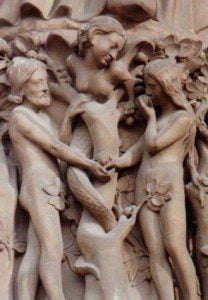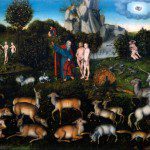 The second section of the new book from the Zondervan Counterpoints series: Four Views on the Historical Adam looks at John Walton’s view of Adam. Walton presents an archetypal view of Adam derived from Scripture and consistent with a number of scientific views of human origins. Again in this first post I will outline Walton’s view without much comment. This will be followed by a post that discusses the responses of the other three contributors and the rejoinder by original author along with some of my own observations.
The second section of the new book from the Zondervan Counterpoints series: Four Views on the Historical Adam looks at John Walton’s view of Adam. Walton presents an archetypal view of Adam derived from Scripture and consistent with a number of scientific views of human origins. Again in this first post I will outline Walton’s view without much comment. This will be followed by a post that discusses the responses of the other three contributors and the rejoinder by original author along with some of my own observations.
John Walton emphasizes at several points throughout the chapter that he views Adam and Eve as historical figures. He opens with this affirmation.
My view is that Adam and Eve were real people in a real past; they were individual persons who existed in history. The basis for this conclusion comes from the fact that in the Old Testament Adam becomes part of a genealogy and in the New Testament a real event featuring real people is the clearest reading to explain the entrance of sin and death. Nevertheless I also believe that the biblical text is most interested in Adam and Eve as archetypes – those who represent humanity. In particular the “making” accounts in Genesis 2 reflect their roles as archetypes and therefore give us no scientific information about human origins. (p. 89-90)
In this post we will leave aside Adam and Eve as real people for the most part and look at the archetypal view Walton outlines. Walton believes that the authors of Genesis and in the New Testament were more interested in the role of Adam and Eve as archetypes than as unique individuals. “An archetype serves as a representative of all other members of the group, thus establishing an inherent relationship” and “an archetype can be a real person with a real past, although not all archetypes are.” (p. 90)
Adam as an archetype in Genesis. The first reason is that the man is called Adam and adam is the Hebrew word for mankind. But the Hebrew language developed after the Exodus and the events described in the text are long before the development of Hebrew as a language. Walton concludes that it cannot be viewed as the actual name of the man. The name is archetypal and everything this man does in Genesis 2-3 is archetypal – “as a representative for all humanity or on behalf of all males.” (p. 91)
Second – the man is formed from the dust. There are issues with the material formation of man from dust. Dust certainly doesn’t refer to chemical composition (not much water or carbon in dust) and dust cannot be sculpted the way clay can. The text doesn’t speak to material composition or to the mechanics or process of human origins. Walton sees the importance in the man being mortal (from the dust) and designed for a role. The tree of life in the garden is the antidote for mortality – it would be unnecessary if the man was created inherently immortal.
Third – the man is taken and placed in a garden.
I would propose that Adam, the archetypal human, is being removed from the everyday realm of human existence and placed in a specially prepared place (the mouth of the rivers) as a blessing. If other people are around, he is being elected from them to play a special role. (p. 94)
Genesis 4 makes it reasonable to assume that other people are around.
Fourth – the man is assigned a priestly role in the garden. The words translated “work and take care of” in the NIV can be interpreted as agricultural work, although the word šamar translated “take care of” does not generally refer to such agricultural work. It is used in the Pentateuch to refer to priestly service in sacred space, guarding sacred space.
 What about Eve? Walton also sees an archetypal role for Eve. Genesis 2:21-22 doesn’t refer to the material origin of Eve, but to a vision showing Adam that he should view Eve as a part of himself. Eve is not a “reproduction partner” but “a coworker in the task of maintaining and expanding sacred space.” (p. 103)
What about Eve? Walton also sees an archetypal role for Eve. Genesis 2:21-22 doesn’t refer to the material origin of Eve, but to a vision showing Adam that he should view Eve as a part of himself. Eve is not a “reproduction partner” but “a coworker in the task of maintaining and expanding sacred space.” (p. 103)
Theological Meaning. The archetypal role of Adam and Eve brings attention to the theological teaching of Genesis.(pp. 102-103)
1. Humankind was created mortal.
2. Humankind was provisioned by God.
3. Humankind was given the role of serving in sacred space (which implies relationship with God).
4. Humankind genders work together to fulfill their God-given role.
5. Humankind was divided into male and female so we would seek to reconnect in a new familial relationship.
Number 4 is worth some elaboration. Walton concludes that the countercultural gender roles in Genesis 2 makes the “Adam as Israel” interpretation of Genesis 2-3 unlikely (Peter Enns supports such a view in his book The Evolution of Adam). Eve is a coworker in maintaining and expanding sacred space and Israel does not have women priests. “Genesis 1-3 shows no sign of patriarchy, and the archetypal woman is given a role as coworker in sacred space, placed in equal relationship with God.” (p. 104)
A Final Note on the Interpretation of Genesis. Walton does not see Genesis 1 and 2 as synoptic accounts of creation with Genesis 2 providing more detail on day 6. This is a typical conservative Christian reading that is not really supported by the structure of the two passages. Walton also does not see the accounts as competing traditions that “came to be incongruently next to each other with unresolved tensions” (p. 109) as critical scholars often claim. Rather he sees them as sequential. Genesis 2 is a sequel to Genesis 1. Genesis 2 recounts events that could have occurred much later.
In such a case, Adam and Eve would not necessarily be envisioned as the first human beings, but would be elect individuals drawn out of the human population and given a particular representative role in sacred space. (p. 109)
The New Testament. According Walton the New Testament authors saw Adam and Eve as real people, “but the theological use that is made of them is archetypal.”
The reference in Acts 17:26 (From one man he made all the nations, that they should inhabit the whole earth) refers to Noah not Adam – the nations are delineated after the flood.
Romans 5:12-14 uses Adam in an archetypal manner – he is a pattern of Christ and he represents all people. Because this passage affirms an event where sin and death entered human experience Walton believes that it supports a historical Adam. However, it says nothing about the transmission of sin, biological relationships, or material discontinuity with the rest of creation.
1 Cor. 15:22 (For as in Adam all die, so in Christ all will be made alive) makes a comparison. This is a representative comparison not determined by biological relationship.
1 Cor. 15:45 (So it is written: “The first man Adam became a living being”; the last Adam, a life-giving spirit.) In this passage the biblical point is to contrast and compare and to exalt Jesus – not to make claims about biology.
2 Cor. 11:3 implies a historical Eve, “but it refers to her archetypally as an analogy.” (p. 107)
1 Timothy 2:13-14 “Adam and Eve are used as archetypes to make a point about all of humanity, here providing an illustration of how a deceived woman can lead a man into error.” (p. 107)
The major passages of concern are those in Romans and 1 Cor. 15 where comparison is made with Christ. While Walton sees this comparison as relating to a unique individual, he does not think that the use as archetype requires biological descent from Adam or that it says anything about material origins. We are not all descended from Christ in a material sense and as the “last Adam” Jesus was neither the only or the last man in biological descent.
Closing thoughts. Walton concludes his chapter with a hypothetical scenario looking at how all the elements that he sees in the text of Genesis and the uses of this text in the New Testament might be brought together. I am not going to summarize this in the post. The bottom line for Walton is that “the Bible is not revealing science, it is revealing God” (p. 116). This includes the material origins of humanity – this is not a subject that the ancient Israelites were concerned with and it is not a subject that the Bible speaks to directly. It is the archetypal role of Adam and Eve that takes center stage in every instance. “The theology is important, but the theology is built on the archetypal profile – we are all represented in Adam and Eve” (p. 117).
Scientific discussions of human origins can be separated from the theological message of the text. Clearly a godless, purposeless view of evolution and human origins is not consistent with Scripture, but a powerful and sovereign God can work through evolutionary process as he works through other so-called “natural” processes including weather and embryonic development.
The next post on this book will look at the responses from Denis Lamoureux, Jack Collins, and William Barrick along with some of my own reflections.
What do you think of Walton’s view?
Does Scripture use Adam and Eve archetypally?
Does material origin matter to the theological message?
If you wish to contact me directly, you may do so at rjs4mail[at]att.net
If interested you can subscribe to a full text feed of my posts at Musings on Science and Theology.











